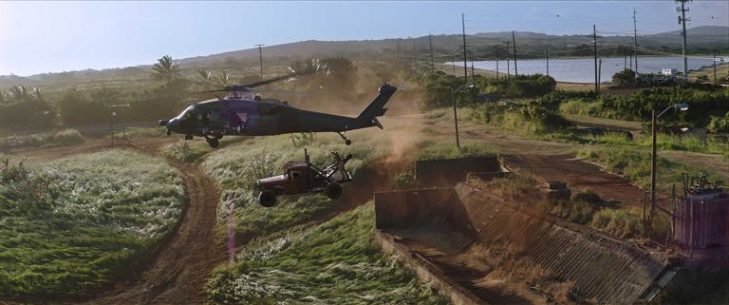Hobbs & Shaw Visual Effects

DNEG was the lead VFX vendor on the ‘Fast and Furious’ franchise spin-off ‘Hobbs & Shaw’, directed by David Leitch. They delivered around 1,000 shots across 26 sequences, including complex FX simulations, extensive environment and build work, animation, digi doubles and motion graphics.
Framestore delivered 235 shots , which involves a perilous car chase and culminates in one of the year’s most audacious action sequences.

Framestore’s first foray into the Fast & Furious universe required a VFX crew to deploy to Hawaii for a five-week stint, where the team captured and processed two kilometres of coastline. “We spent days and days leaning out of cars and hanging out of helicopters shooting array plates,” says VFX Supervisor Ben Loch. “The weather conditions out there kept us on our toes, but in the end we were able to get exactly what we needed. This served us well later on, whether we needed to recreate stretches of the stunning Hawaiian environment wholesale or tweak certain features – like the cliffs – to make them more imposing and dangerous.”
Some of the team’s research, however, was slightly more sedate. “We also spent a lot of time in Hawaiian garden centres and nurseries learning about and cataloguing Hawaiian flora,” says VFX Supervisor Kyle McCulloch. “Being on the ground there was also a real help when it came to digitally recreating the vehicles. It meant we could get granular detail on every aspect of the cars and the helicopter, ensuring we could accurately recreate them aesthetically but also see what happens when the vehicles were put through their paces – the way things flex, bounce and skid, and how the metal tenses under pressure. We were also able to get some great photos of Ben covered head to toe in dust and dirt from being too close to the Black Hawk helicopter.”
If being on location in Hawaii sounds like a dream gig, it ultimately had a more serious aim: the team knew from the outset that they’d have just 16 weeks to pull the sequence together when they returned to London. “The schedule was obviously tight, but having this wealth of material meant we could hit the ground running and maintain that momentum once we’d got started,” says Loch. “Much like the chase sequence, the pace didn’t let up, and we were getting a new edit every two or three days. We pre-planned everything to the nth degree, and having a crack team to work with made the process go really smoothly.”
As well as the material captured in-house, the filmmakers were committed to shooting as much as possible, which gave Framestore’s creatives even more to draw from. The film’s final sequence is a seamless blend of CG and live footage, with Framestore replacing and recreating vehicles, adding smoke and dust, conjuring extreme weather patterns, and augmenting practical FX and explosions. Oh, and that two kilometres of cliff face and coastline that were so painstakingly recreated in CG? Chunks of that were gleefully crumbled and blown to smithereens. “One of the fun things about the Fast & Furious films is that the team behind them is always demanding more on-screen danger and more jeopardy for the characters,” says McCulloch. “The filmmakers don’t do anything by halves, so it was all about ramping up the action and kicking things into overdrive. This meant our Comp Supervisor Oliver Armstrong really had his work cut out, but the end result is note-perfect.”
The sequence culminates in the audacious ‘daisychain’ scene, which sees heroes Luke Hobbs (Dwayne Johnson) and Deckard Shaw (Jason Statham) take down hi-tech villain Brixton Lorr (Idris Elba) as he tries to make his escape in a sleek Black Hawk helicopter. The chase grows ever more elaborate, with a caravan of four bespoke, souped-up vehicles using winches, grappling hooks, chains and pure human strength to keep Lorr’s helicopter tethered. At one point the chain of vehicles teeters on a cliff edge over the churning Pacific Ocean below – a moment that will have cinemagoers chewing their nails down to the quick. “It goes back to constantly ramping up the danger,” says Loch. “The filmmakers always wanted bigger, better and crazier and that’s what we wanted to deliver. At the same time, though, it had to be somewhat grounded. We want people to be bowled over and inhaling their popcorn, but you don’t want to take them out of the action with something that just looks daft. Ordinarily when we’re working with vehicles on a chase scene you might run it through a sim, but that didn’t really work here because what we were doing was quite literally impossible. Hats off to the show’s Animation Supervisor Max Solomon and his team, because it was their work that adds the crunching sense of weight that helps you suspend your disbelief when the action really goes off the hook.”
The 235-shot sequence drew from Framestore’s wide pool of expert creatives, from its modellers and animators to its environment and comp teams. The result is an adrenalized, explosive, edge-of-the-seat slice of action that is sure to be one of the film’s most talked-about moments, and Framestore was proud to be a part of it.
Source:Animation Boss

熱門頭條新聞
- 2025 Edition: Hungary, music video and an anniversary!
- SONY and Kadokawa Group have strengthened their collaboration to maximize their intellectual property
- QUByte Unveils Dark and Nostalgic Adventures for Consoles and PC
- OIAF2025
- Once Human Launching Three New Scenarios & Mobile Version In 2025
- ‘Memoir of A Snail’ to Open Anima Festival 2025
- New STALCRAFT: X Game Mode Revealed in New Trailer Showcased at The Game Awards
- Can CD Projekt Recapture the Magic?
